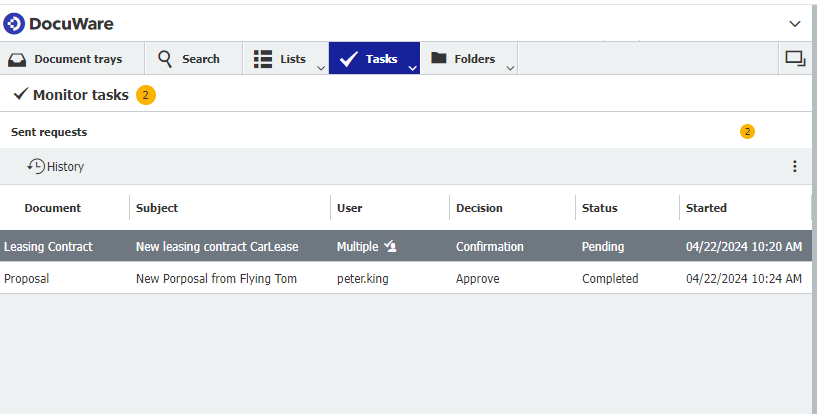Do you need to approve or confirm a document? The "Send request" function in DocuWare is ideal for coordinating decisions in the short term and making them traceable in the long term — without any prior configuration. This flexible ad-hoc workflow is now even easier to use.
Content
- Advantages and flexibility of ad-hoc workflows
- Practical use cases for ad-hoc workflows
- Send request: how to start an ad-hoc workflow
- Define decision options
- Traceability through stamps on the document
- Handling a request and monitoring status
Advantages and flexibility of ad-hoc workflows
Automated workflows usually run according to fixed parameters that have been defined and configured in detail in advance.
With the "Send request" function, DocuWare also offers the option of starting workflows according to the situation – for example, to quickly get an approval. The flexibility of this kind of ad-hoc workflow is especially practical. This allows you to individually determine who is involved, whether they receive the task at the same time or sequentially, and whether the request is completed when one or all of the people have completed the task. Other decision-making options are also fully definable – for example, with options such as "Approve" and "Reject" or even just with an option such as "Please note."
Practical use cases for ad-hoc workflows
A classic application of the ad hoc workflow is approving documents by one or multiple people. Let's say you've received a quote and archived it in DocuWare. Now various team members are asked to give feedback on whether they agree with the offer. To handle this process without a long email ping-pong, start an ad-hoc workflow via "Send request." Or maybe you've received an order and want to apply a discount that needs to be approved by sales management – something that’s done very quickly with an ad-hoc workflow.
Another popular application is the confirmation or acknowledgement of a document that you want to request from colleagues. For example, if a contract clause has changed and you want everyone involved in the project to take note, simply forward the contract to everyone by clicking on "Send a request" and have it confirmed by receipt.
Send request: how to start an ad-hoc workflow
You can start an ad-hoc workflow using the "Send request" function, which is available directly in the context menu of a filed document. Also, you can find the feature in the viewer's toolbar. For quick access, you can also pin the feature to your results lists.

Define decision options
Once you click on "Send request," a new window will open where you can set up the details of a situational workflow with a few clicks. You simply add the users involved using the plus sign and then using the drop-down list. If you want an email notification to be sent at the same time as the request, enable this option. A subject, a text and the two decision options "Approve" and "Reject" are already entered. However, you can change these entries to your specific needs. It is also possible to use a single-user decision option for a more streamlined progression. As in this example:

Traceability through stamps on the document
Check the "Details" box if you want the decisions to be visible as stamps on the document later. Furthermore, the stamp always contains the text that you entered above as a decision option. For even more clarity, you can adjust the color of the stamps per decision:

Handling a request and monitoring status
Once you have submitted your request, the users selected will receive it in their tasks:

As the initiator, you can easily view the status of your sent requests under "Monitor tasks." As of DocuWare version 7.10, the list of "Sent requests" also displays a status column with the note "Completed" or "Pending." Click on the request at the bottom of the page to find the real-time status details:

Licensing Note: The "Submit Request" feature described in this article is included with DocuWare Cloud. If you are using DocuWare as an on-premises system, it is available to you via the Workflow Manager add-on module. There are no settings required in Workflow Designer to use the feature.

